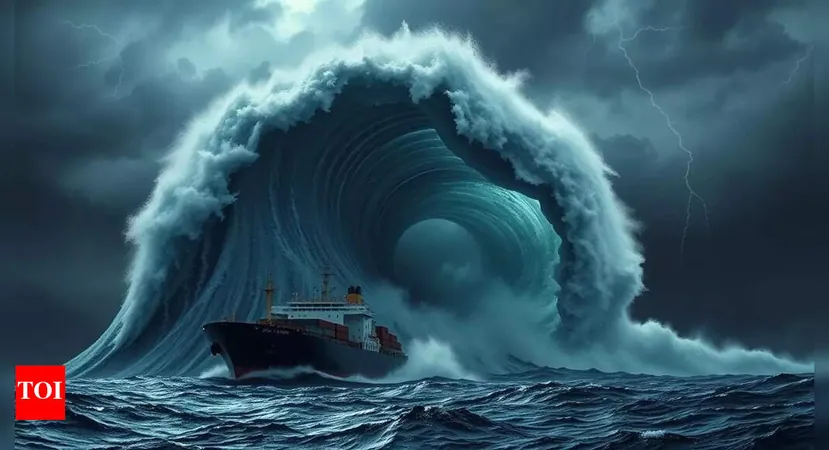
The Terrifying Truth About Rogue Waves: Are We Prepared?
2025-09-01
Author: Daniel
Rogue Waves: Nature's Silent Killers
Rogue waves are colossal and unpredictable, representing a serious threat to maritime safety. The tragic tales of the MS München and MV Derbyshire underscore their deadly capabilities. As scientists delve into the connections between climate change, wind speeds, and the emergence of rogue waves, there’s a glimmer of hope offered by AI technology that could predict these extreme phenomena.
Mysterious Disappearances at Sea
The fate of the MS München remains a haunting mystery. This 850-foot vessel seemingly vanished after possibly being struck by a rogue wave while traversing the North Atlantic on December 12, 1978. Despite sending out a faint distress call, the ship, along with its crew of 28, was never found. In a similar vein, the MV Derbyshire, a larger cargo carrier, sank within minutes during a storm in the South China Sea, marking the largest peacetime loss of a British-flagged ship. It took 14 years to locate its wreck, resting four kilometers deep near Okinawa, Japan.
What Exactly Are Rogue Waves?
Rogue waves, by definition, are at least twice the height of surrounding waves, appearing suddenly and disappearing just as quickly. The science behind their formation is still evolving, with two main theories suggesting that either waves traveling at different speeds collide to create a towering wall of water or that smaller waves combine their energy to form a colossal wave. Despite advancements in ship design, the threat of rogue waves persists.
The Influence of Climate Change
A critical factor in rogue wave formation is wind. Wind energy creates waves; therefore, stronger winds lead to more chaotic seas, increasing the likelihood of rogue waves. Experts warn that climate change might exacerbate this phenomenon. According to Amin Chabchoub, head of the Marine Physics and Engineering Unit at the Okinawa Institute of Science and Technology, global warming is set to elevate wind speeds, potentially forming more rogue waves. A British study highlighted a 1% annual increase in rogue wave heights off the U.S. coast, further emphasizing this concern.
Real-World Evidence of Rogue Waves
Researchers have found rogue waves to be more frequent than previously believed. A study in the Southern Ocean revealed instances of waves twice the height of their neighbors occurring every six hours. Wind was identified as a crucial element in these occurrences, as it significantly influences wave growth.
Advancements in Predictive Technology
With advancements in technology, researchers are optimistic about predicting rogue waves. At the University of Maryland, scientists have developed AI tools capable of providing up to five minutes of warning before a rogue wave strikes. This was achieved using a vast array of data from over 170 buoys along the U.S. coastline, allowing for a 70% prediction accuracy. Such a breakthrough could save lives by giving ships and offshore structures critical time to brace for impact.
The Future of Maritime Safety
As we advance our understanding and detection systems of rogue waves, experts believe AI can significantly enhance forecasting accuracy. However, the effectiveness of these models depends heavily on the quality of data and analysis methods used. As research continues, the hope remains that these innovative technologies will one day transform the safety measures at sea, allowing us to confront the lurking peril of rogue waves head-on.



 Brasil (PT)
Brasil (PT)
 Canada (EN)
Canada (EN)
 Chile (ES)
Chile (ES)
 Česko (CS)
Česko (CS)
 대한민국 (KO)
대한민국 (KO)
 España (ES)
España (ES)
 France (FR)
France (FR)
 Hong Kong (EN)
Hong Kong (EN)
 Italia (IT)
Italia (IT)
 日本 (JA)
日本 (JA)
 Magyarország (HU)
Magyarország (HU)
 Norge (NO)
Norge (NO)
 Polska (PL)
Polska (PL)
 Schweiz (DE)
Schweiz (DE)
 Singapore (EN)
Singapore (EN)
 Sverige (SV)
Sverige (SV)
 Suomi (FI)
Suomi (FI)
 Türkiye (TR)
Türkiye (TR)
 الإمارات العربية المتحدة (AR)
الإمارات العربية المتحدة (AR)